
In Western classical music, a motet is mainly a vocal musical composition, of highly diverse form and style, from high medieval music to the present. The motet was one of the pre-eminent polyphonic forms of Renaissance music. According to Margaret Bent, "a piece of music in several parts with words" is as precise a definition of the motet as will serve from the 13th to the late 16th century and beyond. The late 13th-century theorist Johannes de Grocheo believed that the motet was "not to be celebrated in the presence of common people, because they do not notice its subtlety, nor are they delighted in hearing it, but in the presence of the educated and of those who are seeking out subtleties in the arts".
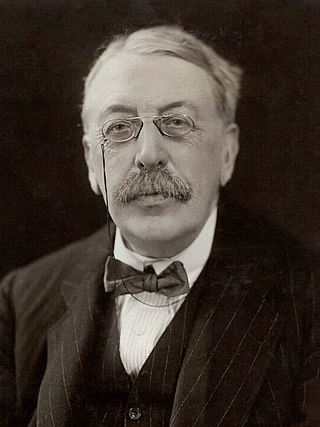
Sir Charles Villiers Stanford was an Anglo-Irish composer, music teacher, and conductor of the late Romantic era. Born to a well-off and highly musical family in Dublin, Stanford was educated at the University of Cambridge before studying music in Leipzig and Berlin. He was instrumental in raising the status of the Cambridge University Musical Society, attracting international stars to perform with it.

Michel Richard Delalande [de Lalande] was a French Baroque composer and organist who was in the service of King Louis XIV. He was one of the most important composers of grands motets. He also wrote orchestral suites known as Simphonies pour les Soupers du Roy and ballets.

Patrick Hawes is a British composer, conductor, organist and pianist.
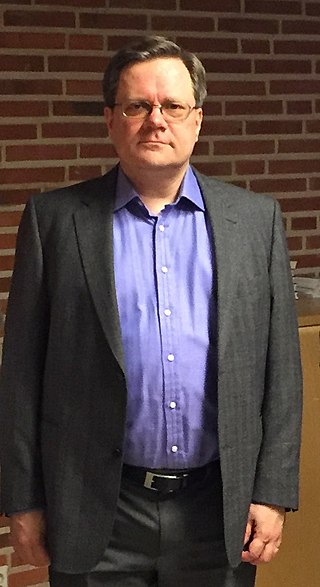
Jaakko Mäntyjärvi is a Finnish composer of classical music, and a professional translator.
"Ubi caritas" is a hymn of the Western Church, long used as one of the antiphons for the washing of feet on Maundy Thursday. Its text is attributed to Paulinus of Aquileia in 796. The traditional melody probably also stems from the late 8th century. It is now and then sung at Eucharistic Adoration and Benediction of the Blessed Sacrament and has for a long time been part of the Holy Thursday evening liturgy. The current Roman Catholic Missal reassigned it from the foot-washing mandatum to the offertory procession at the Holy Thursday evening Mass of the Lord's Supper. It also is found in current Anglican and Lutheran hymnals.
Ciro Grassi was an Italian composer, organist and teacher.

Tre Motetter, FS 139, Op. 55, is a composition for unaccompanied choir by Carl Nielsen. It is a setting of three quotations in Latin from different psalms chosen by the composer and his wife Anne Marie Carl-Nielsen. The three motets, Afflictus sum, Dominus regit me and Benedictus Dominus were first performed on 11 April 1930 at the Ny Carlsberg Glyptotek by Mogens Wöldike and the Palestrina choir, to whom they are dedicated. Among the composer's last works, they were published in 1931 by the Skandinavisk Musikforlag in Copenhagen.

Unser lieben Frauen Traum Op. 138, No. 4, is a sacred motet for unaccompanied mixed choir by Max Reger. The German text is a poem by an anonymous poet, derived from a Volkslied. The piece is in F major and scored for up to six voices, SSATBB. Composed in Meiningen in 1914, it was published in 1916 after Reger's death as the fourth of Acht geistliche Gesänge. It is often performed in Advent.

Der Mensch lebt und bestehet, Op. 138, No. 1, is a sacred motet for unaccompanied mixed choir by Max Reger. The German text is a poem by Matthias Claudius, beginning with "Der Mensch lebt und bestehet nur eine kleine Zeit". The piece is in A minor and scored for eight voices in two choirs SATB. Composed in Meiningen in 1914, it was published in 1916 after Reger's death as the first of Acht geistliche Gesänge.

The Service in B-flat major, Op. 10, is a collection of Anglican church music by Charles Villiers Stanford for mixed choir and organ containing the canticles for each of the principal services of the Anglican Church. Stanford set the traditional liturgical texts in English in 1879 when he was the organist of Trinity College, Cambridge. They were published by Novello in 1902. Stanford orchestrated the work in 1903, with additional organ.
Songs of Farewell is a set of six choral motets by the British composer Hubert Parry. The pieces were composed between 1916 and 1918 and were among his last compositions before his death.

Ave Maria is a short motet for SATB chorus by Russian composer Igor Stravinsky.
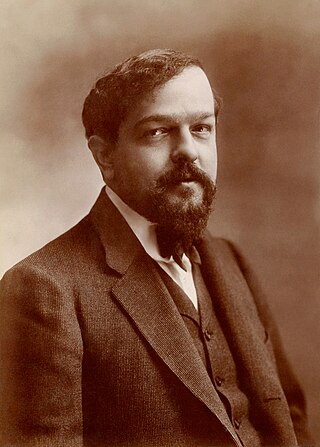
Trois Chansons, or Chansons de Charles d’Orléans, L 99 (92), is an a cappella choir composition by Claude Debussy set to the medieval poetry of Charles, Duke of Orléans (1394–1465). Debussy wrote the first and third songs in 1898 and finished the second in 1908. He premiered the piece in 1909 and Trois Chansons is his only composition for unaccompanied choir.

The Violin Sonata No. 1 in D major, Op. 11, was composed by Charles Villiers Stanford in 1877, shortly after the composer completed his studies in Germany. It was one of his first pieces of chamber music, preceded only by his A major cello sonata. First performed the year it was composed, the sonata was published in 1878 by Ries & Erler in Germany, with a dedication to violinist Ludwig Straus.
"Ye Choirs of New Jerusalem" or "Sing, Choirs of New Jerusalem" is an English Easter hymn by Robert Campbell. It is a 19th-century translation of the medieval Chorus novae Ierusalem, attributed to Fulbert of Chartres. The text's primary focus is the Resurrection of Jesus, taking the theme of Jesus as triumphant victor over death and deliverer of the prisoners from Hell.
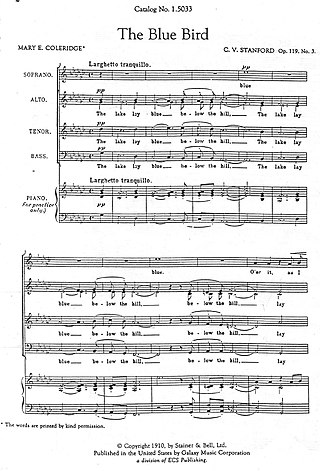
The Blue Bird is a partsong composed by Charles Villiers Stanford in 1910. It is set to the words of L'Oiseau Bleu, a poem by Mary Elizabeth Coleridge, which depicts a bluebird in flight over a lake. It is written for soprano, divided altos, tenor and bass. "The Blue Bird" is the third of Stanford's Eight Part Songs which are all settings of texts by Coleridge. It was widely performed by choral societies in England during Stanford's life and is considered one of the best English partsongs ever written. It has been recorded by ensembles including The Cambridge Singers, Oxford Camerata, Tenebrae, and the Gabrieli Consort.

Locus iste, is a sacred motet composed by Paul Mealor in 2011. The text is the Latin gradual Locus iste for the annual celebration of a church's dedication. Mealor set it for four unaccompanied voices, at times divided, for the 500th anniversary of the King's College Chapel in Aberdeen in 2009.
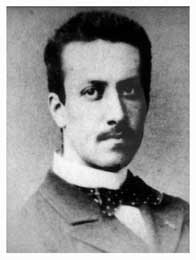
Surrexit a mortuis, Op. 23, No. 3, is a composition for choir and two organs by Charles-Marie Widor. The text is an anonymous Latin Easter hymn. Named a motet, it was first published by Hamelle in 1906. The single work was published by Dr. J. Butz in 2008.













